

How to Decide Between Building or Buying AI Solutions






Build or buy choices still matter in 2026 because products evolve quickly, teams need faster delivery, and technology keeps shifting. Every decision affects long-term cost, control, and innovation.
Companies must evaluate what helps them move faster while keeping the system stable and ready for future change. Requirements change often, cloud tools grow every month, and teams want freedom to move quickly.
Modern companies use many software services and must choose tools that work well together. Clear decisions about what to build and what to buy help teams stay efficient, manage risk, and support changing business needs.
This article explains key trade-offs, a simple decision checklist, and a straightforward way to choose based on business goals, technical limits, and long-term needs.
Creating your own AI system can sound appealing if you already have a capable tech team. It lets you design something that fits your business perfectly, but it also takes time, effort, and money. Let us have a look at what you gain and what you might lose when you choose to build your own AI.
Building your own AI can come with some substantial benefits that make it worth considering. Here are a few of them:
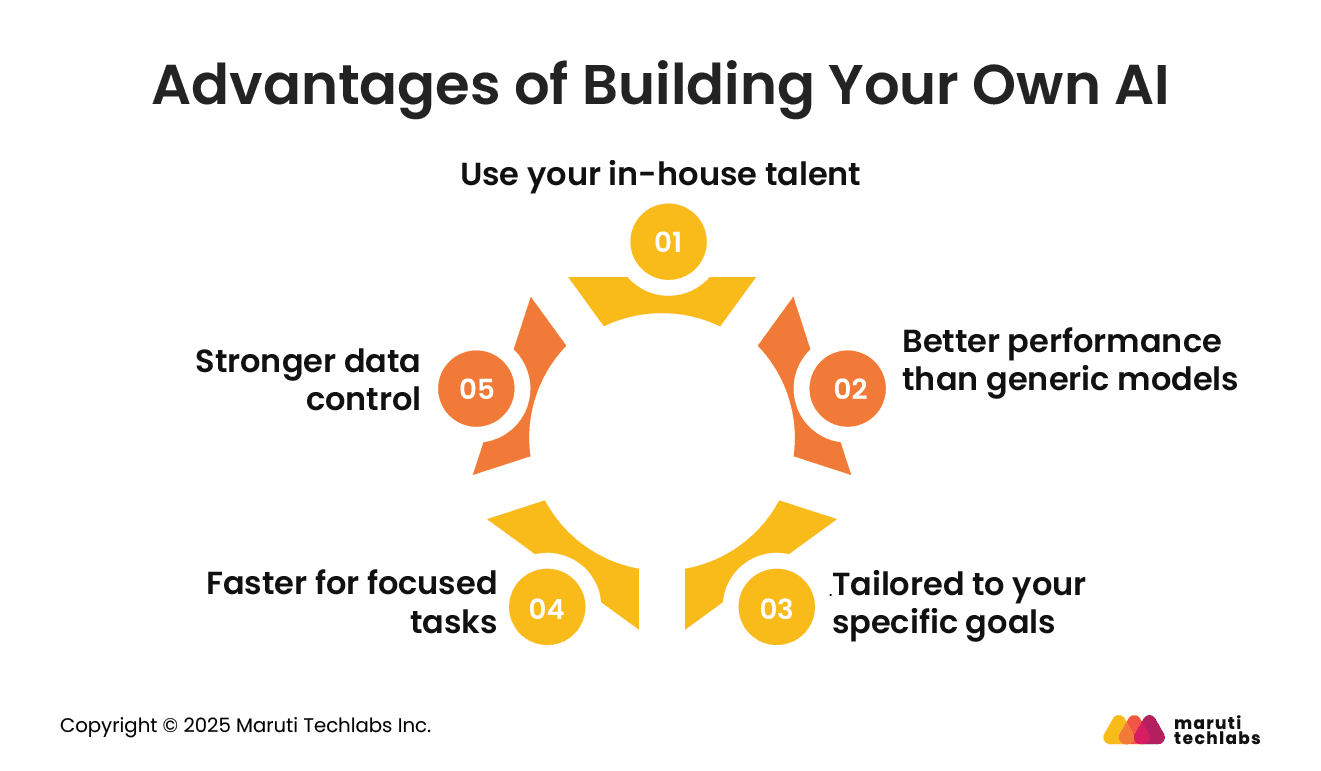
While building your own AI gives you control, it also brings a few challenges you should think about before deciding. Here are some of them:
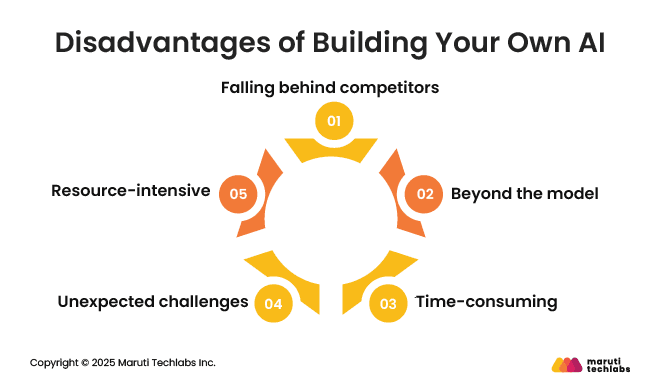
In short, building your own AI can give you greater control and better alignment with your business, but it demands patience, technical expertise, and a long-term commitment to see real results.
A ready-made AI solution can be a smart and practical choice for many businesses. It helps you get started faster, saves effort, and gives access to proven technology. But like any approach, it comes with both benefits and drawbacks. Here’s a simple look at what you can gain and what to keep in mind when choosing to buy an AI solution.
A pre-built AI system offers several benefits that make it easier for businesses to adopt AI without heavy development work. Here are some key advantages:
Quick to set up: You can start using the AI system much faster than building one from scratch. Most vendors offer ready-made solutions that can be integrated easily, helping your business see results sooner.
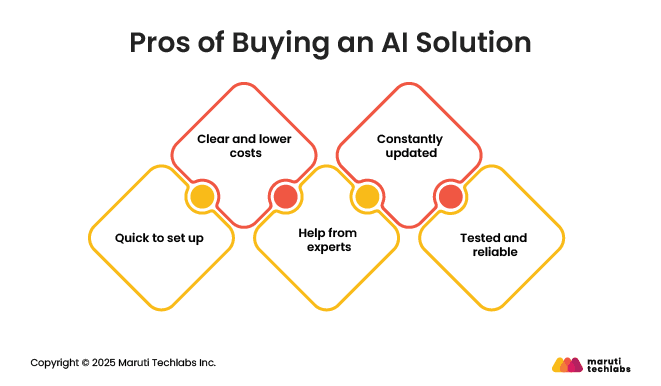
While buying an AI solution is quick and convenient, it also has some downsides to consider:
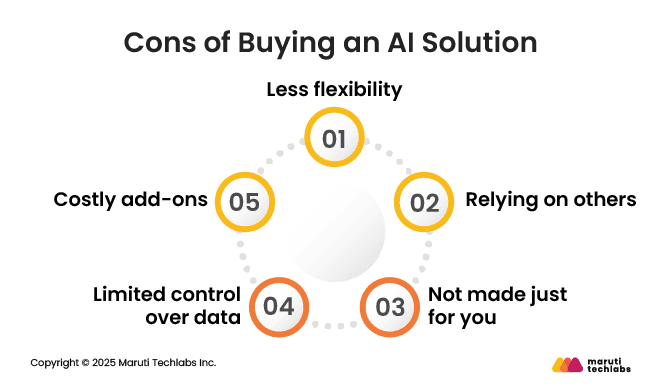
Buying an AI solution lets you get started quickly with minimal effort, but it’s important to ensure it aligns with your long-term objectives. The right choice ultimately depends on your business priorities, budget, and the level of control you want over your AI system.
Understanding the actual cost of AI is essential when deciding whether to build or buy. A detailed build vs buy analysis shows that costs go far beyond just the initial investment. Here’s a simple breakdown:
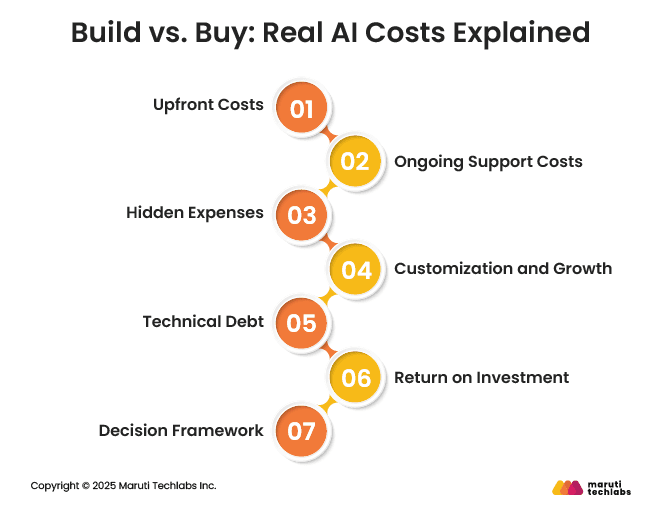
This approach helps businesses see the whole picture beyond initial costs when making build vs buy decisions.
Before choosing a path, evaluate the problem with a structured list. This helps teams stay objective, avoid emotional decisions, and compare options using the same standards.
Decide if the feature is something every company uses or something that gives you an edge. Generic needs usually fit ready-made tools. Unique needs may deserve custom work. Look at long-term business goals and confirm if the feature affects customer experience or internal efficiency in a meaningful way.
If you need to launch quickly, ready tools help you move fast. Custom work takes time for design, testing, and improvement. Consider how delays will affect customer growth or revenue. When speed is the goal, buying may reduce risk and help teams focus on delivering value soon.
Short-term cost is only one part of the choice. Custom work may cost more now but less later. Ready tools may cost less now but more over time. Compare both with expected change, usage growth, and required upgrades. A clear multi year view saves teams from costly surprises.
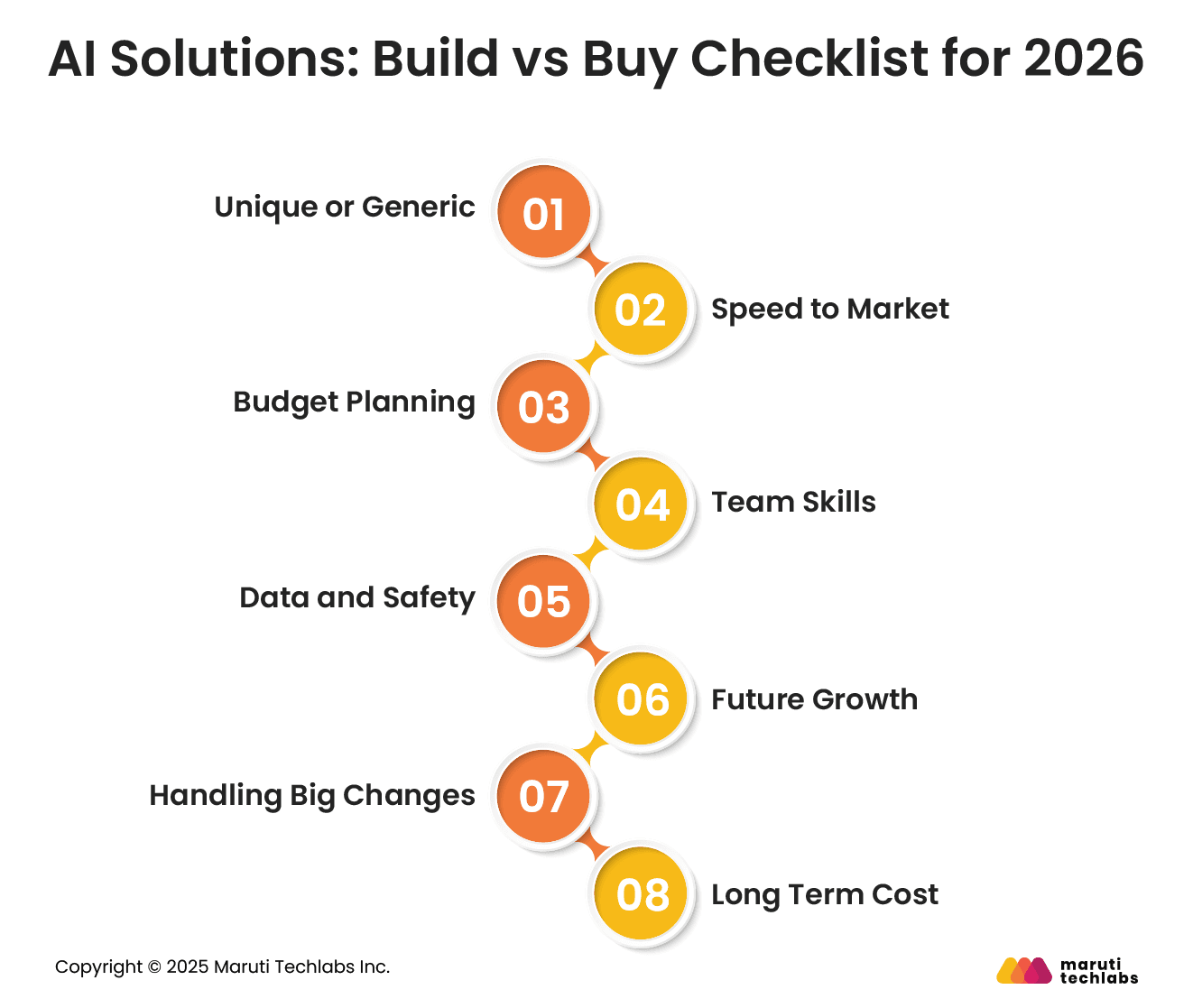
Check if your team has the knowledge to build and support the product. Custom work needs strong design, coding, and testing skills. If the team is already busy, delivery slows down. Buying helps when talent is limited. Choose the option that offers stable progress over time.
Some products hold essential customer or business data. If you must protect this data, confirm how the tool stores, manages, and shares it. Custom work gives more control. Ready tools offer tested controls. Choose based on the level of safety and legal needs you must meet.
Think about the expected change in users, data, and features. Custom work can grow with your needs, but may require more effort. Ready tools offer built-in growth but may not support every plan. Choose the option that keeps your future path open without heavy adjustment.
Needs may change as the business grows. Some vendors adjust slowly or charge more for changes. Custom work lets your team change the product as needed. Compare how both options support new ideas, new rules, or new customer demands. Pick the one that allows a smoother change.
Cost includes more than license fees. Custom work needs support, fixes, and new features. Ready tools need renewals, upgrades, and add-ons. Calculate the total cost for several years and include training, change effort, and team impact. A complete view helps you avoid costly mistakes.
Many companies find that the best choice is a mix of both. Teams often start with a ready tool because it offers speed, stability, and the essential features needed to launch. After gaining early value, they extend the product with custom parts that support unique business needs.
This path reduces early risk, controls cost, and avoids slow delivery. It also gives space for innovation because the team builds only the parts that make a real difference. With this mix, companies stay flexible, avoid vendor limits, and still move fast. In many cases, it becomes the most balanced and practical way to support both immediate goals and long-term plans.
The choice between building and buying AI is not just about speed or cost; it’s a strategic decision. Businesses need to balance short-term wins with long-term benefits, considering factors such as the criticality of AI to their operations, the sensitivity of the data, the urgency of results, the team's readiness, and the total cost of ownership.
Hybrid AI strategies let companies get the best of both worlds. They can start fast with vendor solutions, modularize their AI stack, and gradually build internal capabilities where it matters most. This reduces risk, accelerates ROI, and prepares organizations for a future where AI touches every part of the business. Common hybrid approaches are:
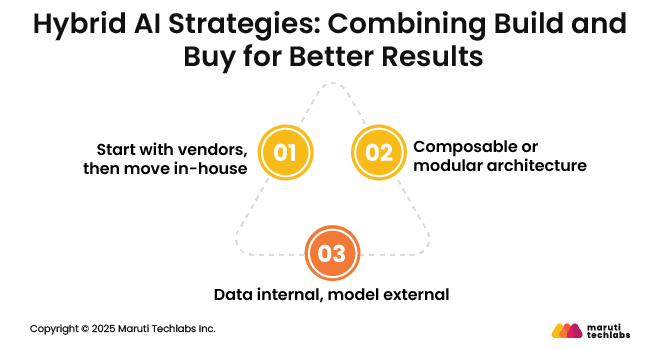
Many companies begin their AI journey using prebuilt models or platforms from vendors to address immediate needs such as forecasting, churn prediction, or anomaly detection. These solutions deliver fast ROI, show proof of value, and give internal teams time to learn. Once teams gain experience, organizations replicate or customize the vendor solutions internally, improving control over models and data and enhancing performance with proprietary insights.
In this approach, companies mix and match AI components. Off-the-shelf tools handle everyday tasks like image recognition or NLP, while custom workflows and decision logic are developed in-house. Open-source libraries like PyTorch or scikit-learn can be combined with cloud tools such as AWS SageMaker or Azure ML.
MLOps platforms like MLflow or Kubeflow help orchestrate pipelines across tools. This reduces vendor lock-in, gives more control over critical workflows, and lets teams build skills gradually without overwhelming resources.
Some businesses keep all data management and storage in-house while running AI models externally through secure APIs or edge deployments. This works well when data privacy or compliance prevents sharing raw data, allowing companies to maintain control over the data lifecycle while benefiting from advanced vendor models.
Hybrid AI strategies provide a flexible path, balancing speed, control, cost, and customization while evolving capabilities as the organization grows.
Teams often rush the decision and miss hidden effort or limits. Knowing common issues helps avoid costly delays and failed projects.
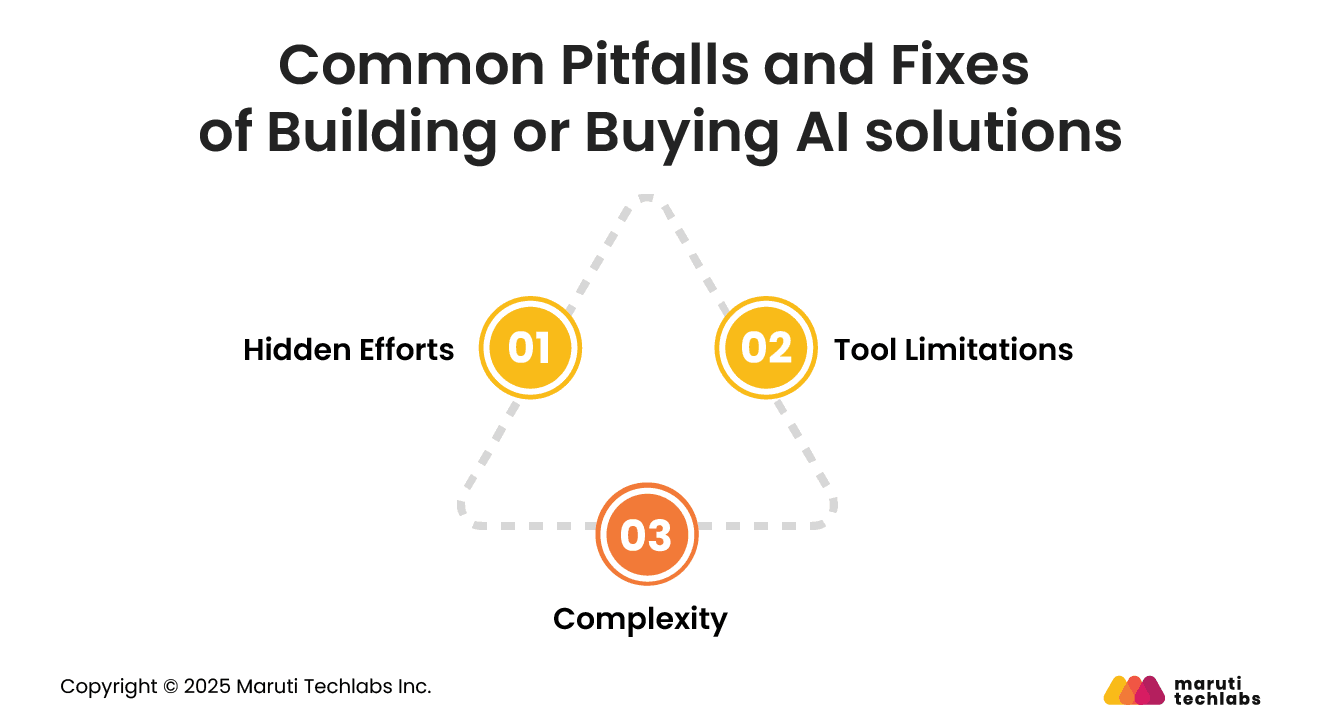
Many teams underestimate the time and care needed to support custom work. Fixing issues, adding small updates, and testing new changes require steady effort. Over time, this adds pressure and slows progress if the team is not ready for ongoing work.
Plan for constant support before you begin. Assign clear owners, set time for fixes, and track change effort.
Review if the team can manage regular updates without slowing other work. A planned support path reduces stress and protects product quality.
Teams sometimes expect ready tools to grow easily or connect with every system. When needs change later, they face slow changes, costly upgrades, or a lack of control. This leads to delays and frustration when the tool cannot support new plans.
Check early how well the tool connects with your systems. Review what changes the vendor supports and how quickly they respond.
Test everyday growth needs before choosing. Pick a tool that offers clear growth paths without high cost.
Some teams design very complicated custom systems when a simple tool could solve the problem. This adds cost, delays, and confusion. It also increases the effort needed to support the system later.
Start with the simplest option that meets the need. Test it with real users. Add custom parts only when the current tool no longer supports key goals.
This keeps the system clean, fast, and easy to maintain.
Deciding whether to build or buy AI solutions is not a simple yes-or-no choice. The right decision depends on your business goals, resources, and long-term strategy. Build vs buy decisions should consider factors like cost, speed, customization, control, and potential ROI.
Buying AI can accelerate adoption, reduce upfront fees, and simplify compliance, while building in-house provides more power, allows customization, and can create a competitive edge.
Many companies now use hybrid strategies, combining the strengths of both approaches to balance speed, flexibility, and control. Leaders should evaluate their team’s skills, data sensitivity, and time-to-value before making a choice. Incorporating a structured AI Strategy & Readiness framework helps organizations ask the right questions, ensure alignment with business objectives, and prepare for sustainable AI-driven growth.
If you want to see how AI can make a difference for your business, take a look at Maruti Techlabs' AI services and get in touch through our contact page. Choosing the right build vs buy approach today can help your business grow and succeed in the future.
To assess your organization’s current capabilities before making the decision, try our AI Readiness Assessment Tool — it helps identify strengths, gaps, and the best path forward for your AI strategy.
Whether it’s better to build or buy in 2025 depends on your organization’s goals, budget, and capabilities. Buying ready-made AI or tech solutions is generally faster, more affordable, and easier to scale. However, building in-house offers greater control, customization, and long-term strategic advantage.
Many businesses in 2025 adopt a hybrid approach, starting with vendor solutions to move quickly, then gradually developing in-house capabilities for critical or differentiated areas.
A buy-and-build strategy mixes buying ready-made AI tools with building custom solutions. Companies use vendor solutions for fast results while gradually developing internal systems. This approach balances speed, cost, control, and customization while growing AI capabilities over time.
Make vs buy analysis helps organizations decide whether to build a solution internally or purchase it from an external vendor. It evaluates factors like cost, time, available resources, expertise, and long-term value to determine the most efficient and strategic option for the business.


